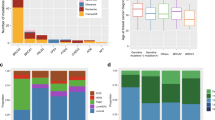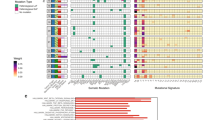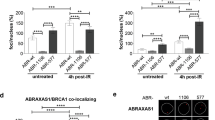Summary
Loss of heterozygosity (LOH) in loci of the 15q15.1, 12p13, 1p32, 17q21 and 13q12–13 regions may collaborate in the inactivation of RAD51, RAD52, RAD54, BRCA1, BRCA2 and possibly other genes implicated in the repair of double-stranded DNA and in DNA recombination. We investigate allelic losses in microsatellites of the RAD51, RAD52, RAD54, BRCA1 and BRCA2 regions, and their correlations with nine pathologic parameters in 127 breast carcinomas. The LOH analysis was performed by amplifying DNA by PCR, using 15 markers of the 15q15.1, 12p13.3, 1p32, 17q21 and 13q12–13 regions. LOH was found in the RAD51 region in 32% of tumours, in the RAD52 region in 16%, in RAD54 in 20% and in the BRCA1 and BRCA2 regions in 49% and 44% respectively. Significant correlations between one or more regions with concomitant LOH and pathologic parameters were observed with respect to age (P = 0.008), oestrogen receptor content (P = 0.03), progesterone receptors (P = 0.003), higher grade (P = 0.001), more advanced stage (P = 0.004) and peritumoural vessel involvement (P < 0.0001). The number of cases in which LOH was observed simultaneously in two or more regions was always higher than expected on the basis of their statistical probability, and curiously, the three patients with LOH at five regions concomitantly were under the age of 30 years. These results suggest that LOH at these regions could be related to breast cancer, and probably to a poor tumour prognosis.
Similar content being viewed by others
Article PDF
Change history
16 November 2011
This paper was modified 12 months after initial publication to switch to Creative Commons licence terms, as noted at publication
References
Beckmann, MW, Picard, F, An, HX, Van Roeyen, CRC, Dominik, SI, Mosny, DS, Schnurch, HG, Bender, HG & Niederacher, D (1996). Clinical impact of detection of loss of heterozygosity of BRCA1 and BRCA2 markers in sporadic breast cancer. Br J Cancer 73: 1220–1226.
Benson, FE, Stasiak, A & West, SC (1994). Purification and characterization of the human Rad51 protein, an analogue of E. coli RecA. EMBO J 13: 5764–5771.
Bièche, I & Lidereau, R (1995). Genetic alterations in breast cancer. Genes Chromosomes Cancer 14: 227–251.
Chapman, MS & Verma, IM (1996). Transcriptional activation by BRCA1. Nature 382: 678–679.
Cleton-Jansen, A-M, Collins, N, Lakhani, SR, Weissenbach, J, Devilee, P, Cornelisse, CJ & Stratton, MR (1995). Loss of heterozygosity in sporadic breast tumours at the BRCA2 locus on chromosome 13q12–q13. Br J Cancer 72: 1241–1244.
Connor, F, Bertwistle, D, Mee, PJ, Ross, GM, Swift, S, Grigorieva, E, Tybulewicz, VLJ & Ashworth, A (1997). Tumorigenesis and a DNA repair defect in mice with a truncating Brca2 mutation. Nature Genet 17: 423–430.
Devilee, P & Cornelisse, C (1994). Somatic genetic changes in human breast cancer. Biochim Biophys Acta 1198: 113–130.
Ellis, NA, Groden, J, Ye, TZ, Straughen, J, Lennon, DJ, Ciocci, S, Proytcheva, M & German, J (1995). The Bloom’s syndrome gene product is homologous to RecQ helicases. Cell 83: 655–666.
Harris, JR, Morrow, M & Norton, L (1997). Malignant tumors of the breast. In: Cancer Principles and Practice of Oncology, 5th edn.DeVita VT, Hellman S, Rosemberg SA Lippincott-Noreu: Philadelphia 2: 1557–1616.
Kerangueven, F, Noguchi, T, Coulier, F, Allione, F, Wargniez, V, Simony-Lafontaine, J, Longy, M, Jackemier, J, Sobol, H, Eisinger, F & Birnbaum, D (1997). Genome-wide search for loss of heterozygosity shows extensive genetic diversity of human breast carcinomas. Cancer Res 57: 5469–5474.
Lancaster, JM, Wooster, R, Mangion, J, Phelan, CM, Cochran, C, Gumbs, C, Seal, S, Barfoof, R, Collins, N, Bignell, G, Patel, S, Hamoudi, R, Larson, C, Wiseman, RW, Berchuck, A, Iglehart, JD, Marks, JR, Ashworth, A, Stratton, MR & Futreal, PA (1996). BRCA2 mutations in primary breast and ovarian cancers. Nature Genet 13: 238–240.
Ludwig, T, Chapman, DL, Papaioannou, VE & Efstratiadis, A (1997). Targeted mutations of breast cancer susceptibility gene homologs in mice: lethal phenotypes of Brcal, Brca2, Brca1/Brca2, Brca1/p53, and Brca2/p53 nullizygous embryos. Genes Dev 11: 1226–1241.
Marmorstein, LY, Ouchi, T & Aaronson, SA (1998). The BRCA2 gene product functionally interacts with p53 and RAD51. Proc Natl Acad Sci USA 95: 13869–13874.
Matson, SW & Kaiser-Rogers, KA (1990). DNA helicases. Annu Rev Biochem 59: 289–329.
Milner, J, Ponder, B, Hughes-Davies, L, Seltman, M & Kouzarides, T (1997). Transcriptional activation functions in BRCA2. Nature 386: 772–773.
Miki, Y, Katagiri, T, Kasumi, F, Yoshimoto, T & Nakamura, Y (1996). Mutation analysis in the BRCA2 gene in primary breast cancers. Nature Genet 13: 245–247.
Muris, DAR, Bezzuvoba, O, Buerstedde, JM, Vreeken, K, Balajee, AS, Osgood, CJ, Troelstra, C, Hoeijmakers, JHJ, Osterman, K, Schmidt, H, Natarajan, AT, Eeken, JCJ, Lohman, PHM & Pastink, A (1994). Cloning of human and mouse genes homologous to RAD52, a yeast gene involved in DNA repair and recombination. Mutation Res 315: 295–305.
Oto, M, Miyake, S & Yuasa, Y (1993). Optimization of nonradioisotopic single strand conformation polymorphism analysis with a conventional minislab gel electrophoresis apparatus. Ann Biochem 213: 19–22.
Park, MS (1995). Expression of human RAD52 confers resistance to ionizing radiation in mammalian cells. J Biol Chem 270: 15467–15470.
Park, MS, Ludwig, DL, Stigger, E & Lee, S-H (1996). Physical interaction between human RAD52 and RPA is required for homologous recombination in mammalian cells. J Biol Chem 271: 18996–18200.
Phelan, CM, Borg, A, Cuny, M, Crichton, DN, Baldersson, T, Andersen, TI, Caligo, MA, Lidereau, R, Lidblom, A, Seitz, S, Kelsell, D, Hamann, U, Rio, P, Thorlacious, S, Papp, J, Olah, E, Ponder, B, Bignon, YJ, Scherneck, S, Barkardottir, R, Borresen-Dale, AL, Eyfjörd, J, Theillet, C, Thompson, AM, Devilee, P & Larsson, C (1998). Consortium study on 1280 breast carcinomas: allelic loss on chromosome 17 targets subregions associated with family history and clinical parameters. Cancer Res 58: 1004–1012.
Rasio, D, Murakumo, Y, Robbins, D, Roth, T, Silver, A, Negrini, M, Schmidt, C, Burczak, J, Fishel, R & Croce, CM (1997). Characterization of the human homologue of RAD54: A gene located on chromosome 1p32 at a region of high loss of heterozygosity in breast tumors. Cancer Res 57: 2378–2383.
Scully, R, Chen, J, Plug, A, Xiao, Y, Weaver, D, Feunteun, J, Ashley, T & Livingston, DM (1997). Association of BRCA1 with Rad51 in mitotic and meiotic cells. Cell 88: 265–275.
Sharan, SK, Morimatsu, M, Albrecht, U, Lim, D-S, Regel, E, Dinh, C, Sands, A, Eichele, G, Hasty, P & Bradley, A (1997). Embryonic lethality and radiation hypersensitivity mediated by Rad51 in mice lacking Brca2. Nature 386: 804–810.
Shen, Z, Cloud, KJ, Chen, DJ & Park, MS (1996). Specific interaction between the human RAD51 and RAD52 proteins. J Biol Chem 271: 148–152.
Shinohara, A, Ogawa, H, Matsuda, Y, Ushio, N, Ikeo, K & Ogawa, T (1993). Cloning of human, mouse and fission yeast recombination genes homologous to RAD51 and recA. Nature Genet 4: 239–243.
Somasundaram, K, Zhang, H, Zeng, YX, Houvras, Y, Peng, Y, Zhang, H, Wu, GS, Licht, JD, Weber, BL & El-Deiry, WS (1997). Arrest of the cell cycle by the tumor-suppressor BRCA1 requires the CDK-inhibitor p21WAF1/CIP1. Nature 389: 187–190.
Stürzbecher, HW, Donzelmann, B, Henning, W, Knippschild, U & Buchhop, S (1996). p53 is linked directly to homologous recombination processes via RAD51/RecA protein interaction. EMBO J 15: 1992–2002.
Sung, P, Bailly, V, Weber, C, Thompson LH Prakash, L & Prakash, S (1993). Human xeroderma pigmentosum group D gene encodes a DNA helicase. Nature 365: 852–855.
Suzuki, A, De La Pompa, JL, Hakem, R, Elia, A, Yoshida, R, Mo, R, Nishina, H, Chuang, T, Wakeham, A, Itie, A, Koo, W, Billia, P, Ho, A, Fukumoto, M, Hui, CC & Mak, TW (1997). Brca2 is required for embryonic cellular proliferation in the mouse. Genes Dev 11: 1242–1252.
Teng, DH-F, Bogden, R, Mitchell, J, Baumgard, M, Bell, R, Berry, S, Davis, T, Ha, PC, Kehrer, R, Jammulapati, S, Chen, Q, Offit, K, Skolnick, MH, Tavtigian, SV, Jhanwar, S, Swedlund, B, Wong, AKC & Kamb, A (1996). Low incidence of BRCA2 mutations in breast carcinoma and other cancers. Nature Genet 13: 241–244.
van der Berg, J, Johannsson, O, Hakansson, S, Olsson, H & Borg, A (1996). Allelic loss at chromosome 13q12–q13 is associated with poor prognosis in familial and sporadic breast cancer. Br J Cancer 74: 1615–1619.
Author information
Authors and Affiliations
Rights and permissions
From twelve months after its original publication, this work is licensed under the Creative Commons Attribution-NonCommercial-Share Alike 3.0 Unported License. To view a copy of this license, visit http://creativecommons.org/licenses/by-nc-sa/3.0/
About this article
Cite this article
Gonzalez, R., Silva, J., Dominguez, G. et al. Detection of loss of heterozygosity at RAD51, RAD52, RAD54 and BRCA1 and BRCA2 loci in breast cancer: pathological correlations. Br J Cancer 81, 503–509 (1999). https://doi.org/10.1038/sj.bjc.6690722
Received:
Revised:
Accepted:
Published:
Issue date:
DOI: https://doi.org/10.1038/sj.bjc.6690722
Keywords
This article is cited by
-
BLM and RAD51 Genes Polymorphism and Susceptibility to Breast Cancer
Pathology & Oncology Research (2013)
-
RAD51 polymorphisms and breast cancer risk
Molecular Biology Reports (2013)
-
RAD51 135G/C polymorphism and breast cancer risk: a meta-analysis from 21 studies
Breast Cancer Research and Treatment (2011)
-
Comprehensive screen of genetic variation in DNA repair pathway genes and postmenopausal breast cancer risk
Breast Cancer Research and Treatment (2011)
-
Prevalence and predictors of loss of wild type BRCA1 in estrogen receptor positive and negative BRCA1-associated breast cancers
Breast Cancer Research (2010)



